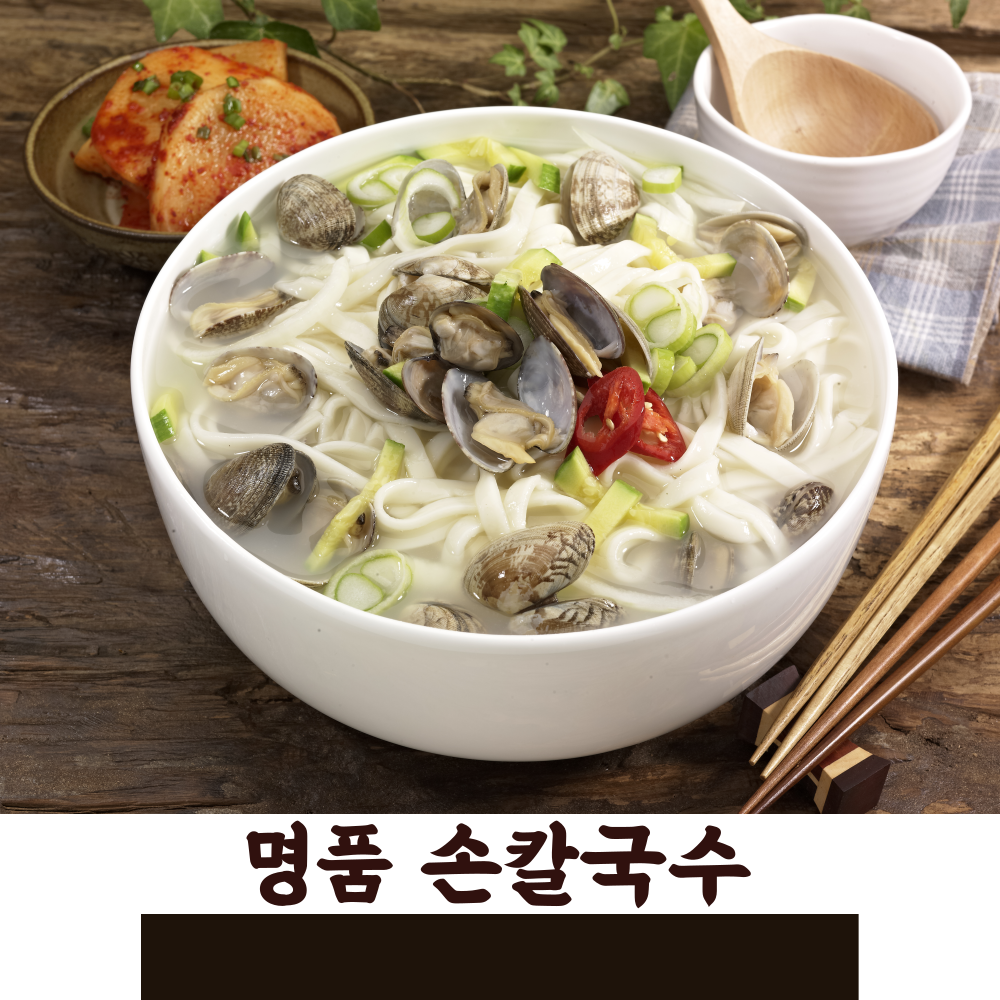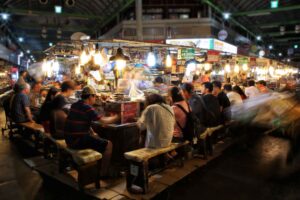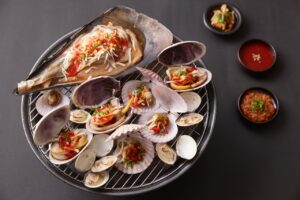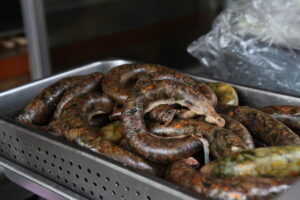
Food During Temple Stay
Korean food is known to be suitable for vegetarians. Among them, temple food is the most vegetarian food. Let’s look at Korean temple food and templestay.
Buddhist Temples are places of worship, meditation, and spiritual practice for followers of Buddhism. They often serve as centers for learning, meditation retreats, and community activities. Buddhist temples can vary in size and style, but they typically have a serene and contemplative atmosphere. In South Korea, temples play a significant role in the country’s cultural and religious landscape.
Temple Stay Programs: A “temple stay” program allows individuals, both locals and tourists, to experience the daily life of Buddhist monks and nuns by staying at a temple for a short period of time. These programs offer participants a chance to learn about Buddhist practices, engage in meditation, and gain insights into the temple’s routines. Temple stay programs are a way to disconnect from the fast-paced world and immerse oneself in a peaceful and mindful environment.
Food during Temple Stay: Food is an integral part of the temple stay experience. Participants are offered simple and vegetarian meals that align with Buddhist dietary principles. The meals are typically prepared with mindfulness and in accordance with the temple’s practices. While specifics can vary from temple to temple, here’s what you might expect:
- Vegetarian Cuisine: Most temple stays offer strictly vegetarian meals, which exclude meat and animal products. The meals are often simple, nutritious, and thoughtfully prepared.
- Mindful Eating: Meals are consumed in silence or in a quiet environment. This encourages participants to eat mindfully and appreciate the flavors and textures of each dish.
- Set Meal Times: Meals are served at specific times, often in the morning and early afternoon. Participants are expected to adhere to the temple’s schedule.
- Community Dining: Participants usually dine together in a communal setting, fostering a sense of togetherness and shared experience.
- Traditional Dishes: Temple stay meals might include rice, various vegetable dishes, tofu-based dishes, soups, and more. The focus is on simple, wholesome, and balanced nutrition.
- Cultural Experience: Sharing meals with monks and fellow participants is a cultural experience that offers insights into temple life, Buddhism, and Korean traditions.
- Respectful Dining: Participants are expected to eat mindfully, avoid wasting food, and follow any eating customs or guidelines set by the temple.
Participating in a temple stay program provides an opportunity not only to learn about Buddhism and temple life but also to embrace a lifestyle of mindfulness and simplicity. The experience of sharing vegetarian meals in a serene temple environment can have a profound impact on one’s perspective and well-being.

Vegetarian Food in Temple Stay
During a temple stay program in Korea, the food served is typically vegetarian and reflects the principles of Buddhist dietary practices. The meals are simple, nutritious, and often prepared with mindfulness. While the exact menu can vary from temple to temple, here are some common types of food that you might find during a temple stay:
- Rice (Bap, 밥): A staple of Korean cuisine, rice is a fundamental part of temple stay meals.
- Various Vegetable Dishes: A variety of vegetable dishes are served, showcasing different flavors, textures, and cooking methods. This can include sautéed, steamed, and stir-fried vegetables.
- Tofu Dishes: Tofu is a protein-rich ingredient and often prepared in different ways, such as grilled, braised, or in soups.
- Namul (Seasoned Vegetables, 나물): Namul dishes are made by blanching or sautéing various types of wild or cultivated greens, and they are a common component of Korean temple cuisine.
- Soups (Guk, 국 or Jjigae, 찌개): Simple vegetable-based soups are served, providing warmth and nourishment.
- Porridge (Juk, 죽): Rice porridge, made by cooking rice in water or broth until it becomes creamy, is often served as a comforting dish.
- Pickled Vegetables (Jangajji, 장아찌): Pickled vegetables add flavor and variety to the meals.
- Fruits: Fresh fruits might be served as a refreshing and naturally sweet element.
- Grains and Legumes: Whole grains and legumes like beans and lentils are sometimes included for added nutrition.
- Tea: Different types of herbal teas, often made from ingredients like ginger, jujube, or omija (Schisandra berries), can be served for refreshment.
- Sesame Oil and Seeds: These are commonly used for flavoring and nutrition.
It’s important to note that the emphasis during a temple stay is on mindfulness, gratitude, and simplicity. Meals are often eaten in silence or with minimal conversation, allowing participants to fully engage with the act of eating. Sharing in the temple’s meals can offer a unique and meaningful experience, fostering a sense of connection to the principles of Buddhism and promoting a sense of well-being.
Templestay Information Center in Seoul
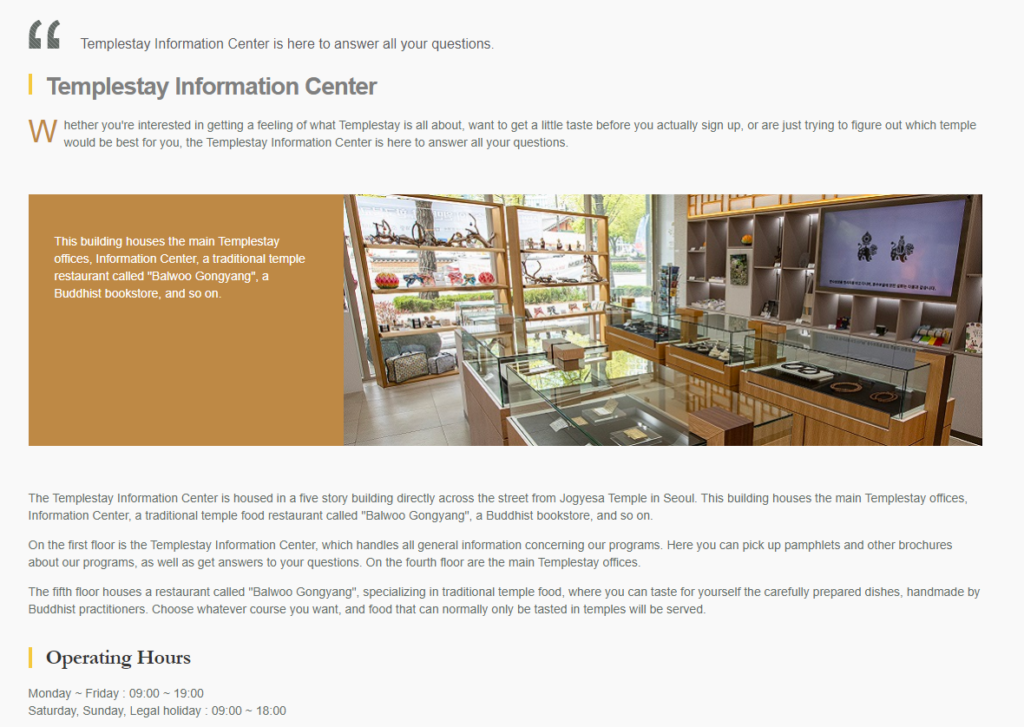

Website for Templestay in Korea

